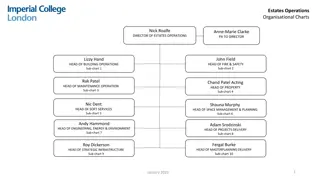Understanding ZFS: Structure and Operations
Explore the comprehensive structure and operations of ZFS, covering aspects like MOS layer, object-set layer, Dnode, Block Pointer, and TRIM operations. Learn about the meta-object set (MOS), dataset and snapshot layer (DSL), and storage pool allocator (SPA) modules within ZFS. Understand how ZVOLs, filesystems, and clones are organized within the Object-Set layer. Discover the role of DNODE in managing objects in the MOS layer and its relationship with ZAP objects in ZFS.
Download Presentation

Please find below an Image/Link to download the presentation.
The content on the website is provided AS IS for your information and personal use only. It may not be sold, licensed, or shared on other websites without obtaining consent from the author. Download presentation by click this link. If you encounter any issues during the download, it is possible that the publisher has removed the file from their server.
E N D
Presentation Transcript
Agenda 1. ZFS Structure and Organisation 1. Overview 2. MOS Layer 3. Object-Set Layer 4. Dnode 5. Block Pointer 2. ZFS Operations 1. Writing new data to disk 2. Freeing blocks 3. TRIM
ZFS Structural Overview uberblock points to a data structure that describes an array of meta- objects meta-objects include filesystems, snapsots, clones, ZVOLs and the space map of free/allocated blocks in the pool MOS object references an object-set that describes its array of objects the objects include things like directories, files, symbolic links, etc Finally, these objects reference an array of blocks that contain the objects' data
Meta-Object Set(MOS) Layer Dataset and Snapshot Layer(DSL) and Storage Pool Allocator(SPA) modules implement the MOS layer It manages the pool of space and makes it available to filesystem modules of object-set layer DSL tracks datasets, which includes snapshots, clones, active filesystems, and ZFS Volumes(ZVOLs), and deadlists SPA tracks allocated vs free blocks in the current pool and is also responsible for handling compression and deduplication
Object-Set Layer ZVOLs - single dnode which references two dnodes disk data - dnode references an array of block pointers master node - records ZVOl-specific information Filesystems - three dnodes 2 dnodes record user and group space usage for a filesystem 3rd dnode references an array of files and directories Clones of filesystem/ZVOL have same organization as the filesystem/ZVOL
DNODE Analogous to INODE but also describes objects in MOS layer. Managed by DMU. Describe files, directories, filesystems, snapshots, clones, space maps etc. Size < 128 Kb -> Direct pointer to appropriate size block else -> 1 level of indirection: points to 16Kb block -> each entry points to 128 Kb blocks. Can increase level of indirection if required. Reference ZAP objects
Block Pointer Checksum for every block ( up to 3 copies of data ). All meta-data blocks have double redundancy by default. Birth time - counted in terms of number of checkpoints since the ZFS pool was created. Dedup flag - quick shortcut
Freeing blocks ds_deadlist_obj in dsl_dataset_phys_t Deadlist -> I don't want this block, but a previous snapshot might. Only free a block if: No references to this block birth_time of the block is more than the birth_time of the latest snapshot While deleting snapshot, free those blocks that Are in the next snapshot's deadlist AND have birth_time greater than previous snapshot.
TRIM - Motivation Attempt to make sure certain writes do not take very long ( as compared to other writes ). SSD Blocks only have a limited number of erases. Using TRIM, a FS can tell the underlying SSD that certain blocks are no longer relevant. TRIM reduces, on average, garbage collection cost and also increases the lifetime of SSDs. TRIM does have overhead - so use judiciously !!























